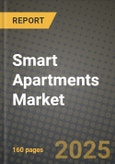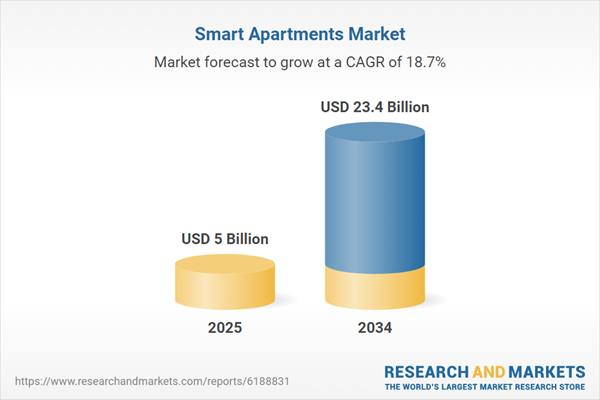The smart apartments market is rapidly transforming the residential real estate landscape, fueled by growing demand for intelligent, connected living spaces that offer convenience, efficiency, and security. A smart apartment is typically equipped with integrated technologies such as IoT-enabled appliances, smart lighting, automated climate control, voice-activated assistants, and advanced security systems, all of which can be monitored and managed remotely via smartphone apps or home hubs. These connected ecosystems are becoming particularly attractive to tech-savvy renters, younger homebuyers, and property managers seeking operational efficiency and differentiation in competitive housing markets. Developers and real estate investors are also leveraging smart apartment features to increase asset value, reduce energy costs, and enhance tenant satisfaction. With the global shift toward digital living and sustainable development, smart apartments are evolving beyond luxury status into a mainstream expectation, especially in urban centers where space efficiency and user experience are top priorities.
The smart apartments market experienced significant acceleration in adoption and product integration. Property developers increasingly included smart amenities as standard offerings in new residential buildings, ranging from keyless entry systems and leak detection sensors to energy usage dashboards and app-based appliance controls. Landlords and property managers deployed centralized platforms to manage connected devices across multiple units, enabling predictive maintenance, automated energy optimization, and remote troubleshooting. Renters showed strong interest in apartments with seamless integration of voice assistants like Alexa and Google Assistant, particularly for lighting, entertainment, and home security functions. In response to heightened awareness around energy consumption, developers implemented smart HVAC systems and solar-powered smart meters, especially in regions with green building regulations. The rental market also began to see increased adoption of modular and retrofittable smart home kits, allowing older buildings to meet modern tenant expectations without complete infrastructure overhauls. Evolving data privacy regulations in the U.S., Europe, and parts of Asia also prompted providers to invest in secure cloud architecture and encrypted device communication.
The smart apartments market is expected to move toward greater interoperability, automation, and personalization. Advancements in edge computing and AI will enable apartments to anticipate user needs, learning preferences for lighting, temperature, and media based on occupancy patterns and contextual triggers. Integration with community-level services - such as smart parking, waste management, and building-wide access control - will become more common, creating a unified ecosystem that enhances resident comfort and operational efficiency for property managers. As housing becomes more hybrid in nature, combining residential and remote workspaces, demand will grow for smart features that support productivity, security, and environmental comfort. Regulatory focus on building sustainability will also drive the adoption of energy-monitoring systems and smart appliances with low carbon footprints. Moreover, integration with broader smart city infrastructure will begin to influence design and development, aligning smart apartments with mobility services, emergency alerts, and grid-responsive energy use. To succeed in this evolving landscape, stakeholders will need to balance innovation with affordability, data transparency, and inclusivity, ensuring smart living benefits are accessible across income levels and geographies.
Key Insights: Smart Apartments Market
- Increased Adoption of Centralized Management Platforms: Property managers are implementing integrated platforms to oversee multiple smart devices and units, enabling automation of maintenance tasks, energy monitoring, and tenant communication from a single interface.
- Growth in Retrofit-Friendly Smart Solutions: Modular smart home kits are gaining popularity among landlords and building owners looking to upgrade existing apartments without requiring major rewiring or structural changes.
- Expansion of AI-Powered Personalization: Smart apartments are beginning to incorporate AI algorithms that learn user habits and automate settings such as lighting, HVAC, and media playback to optimize comfort and energy efficiency.
- Voice Assistant Integration Becoming Standard: Residents are increasingly expecting compatibility with voice assistants, with integration enabling hands-free control of lighting, appliances, security systems, and entertainment devices.
- Enhanced Focus on Data Privacy and Security: With more connected devices in use, manufacturers and developers are investing in secure networks, encrypted communications, and compliance with regional data protection regulations to maintain user trust.
- Rising Demand for Connected Living: Consumers are prioritizing convenience, remote control, and automation in their homes, pushing demand for smart apartment technologies that deliver enhanced daily living experiences.
- Urbanization and Smart City Development: As more people move into urban environments, smart apartments are becoming a cornerstone of smart city strategies focused on sustainable, efficient, and high-tech urban living.
- Operational Efficiency for Property Managers: Smart technologies help landlords reduce costs by enabling predictive maintenance, energy savings, and streamlined tenant services, making these solutions attractive for multi-unit dwellings.
- Government Regulations Promoting Energy Efficiency: Increasing pressure to meet sustainability goals is encouraging developers to install smart systems that track and optimize energy consumption in residential properties.
- Integration Complexity Across Devices and Systems: Lack of standardized protocols among smart devices creates compatibility issues, making it difficult for property owners and tenants to achieve seamless interoperability across brands and platforms.
Smart Apartments Market Segmentation
By Product
- Building Management System (BMS)
- Heating
- Ventilating
- and Air Conditioning (HVAC)
- Lighting Control
- Security and Access Control
- Emergency Alarm and Evacuation System
- Audio and Visual Effects
By Technology
- Wi-Fi
- Bluetooth
- GSM/GPRS
- RFID
- Other Technologies
By Application
- Residential
- Hotel
- Other Applications
Key Companies Analysed
- Amazon.com Inc.
- Leviton Manufacturing Co. Inc.
- Apple Inc.
- Google LLC
- Samsung Electronics Co. Ltd
- Honeywell International Inc.
- Lennar Corporation
- Schneider Electric SE
- August Home
- Asea Brown Boveri Ltd Ltd.
- Pulte Group Inc.
- Rachio Inc.
- Carlisle Companies Inc.
- Meritage Homes Corporation
- Logitech International S.A.
- Yale
- Crestron Electronics Inc.
- Vivint Smart Home Inc.
- Somfy Group
- Metricon Homes LLC
- Netatmo
- Savant Systems LLC
- Ecobee Inc.
- Lutron Electronics Co. Inc.
- Porter Davis Homes
- Shea Homes
- Henley Properties
- Tado GmbH
- Philips Hue
- Control4 Corporation
Smart Apartments Market Analytics
The report employs rigorous tools, including Porter’s Five Forces, value chain mapping, and scenario-based modeling, to assess supply-demand dynamics. Cross-sector influences from parent, derived, and substitute markets are evaluated to identify risks and opportunities. Trade and pricing analytics provide an up-to-date view of international flows, including leading exporters, importers, and regional price trends.Macroeconomic indicators, policy frameworks such as carbon pricing and energy security strategies, and evolving consumer behavior are considered in forecasting scenarios. Recent deal flows, partnerships, and technology innovations are incorporated to assess their impact on future market performance.
Smart Apartments Market Competitive Intelligence
The competitive landscape is mapped through proprietary frameworks, profiling leading companies with details on business models, product portfolios, financial performance, and strategic initiatives. Key developments such as mergers & acquisitions, technology collaborations, investment inflows, and regional expansions are analyzed for their competitive impact. The report also identifies emerging players and innovative startups contributing to market disruption.Regional insights highlight the most promising investment destinations, regulatory landscapes, and evolving partnerships across energy and industrial corridors.
Countries Covered
- North America - Smart Apartments market data and outlook to 2034
- United States
- Canada
- Mexico
- Europe - Smart Apartments market data and outlook to 2034
- Germany
- United Kingdom
- France
- Italy
- Spain
- BeNeLux
- Russia
- Sweden
- Asia-Pacific - Smart Apartments market data and outlook to 2034
- China
- Japan
- India
- South Korea
- Australia
- Indonesia
- Malaysia
- Vietnam
- Middle East and Africa - Smart Apartments market data and outlook to 2034
- Saudi Arabia
- South Africa
- Iran
- UAE
- Egypt
- South and Central America - Smart Apartments market data and outlook to 2034
- Brazil
- Argentina
- Chile
- Peru
Research Methodology
This study combines primary inputs from industry experts across the Smart Apartments value chain with secondary data from associations, government publications, trade databases, and company disclosures. Proprietary modeling techniques, including data triangulation, statistical correlation, and scenario planning, are applied to deliver reliable market sizing and forecasting.Key Questions Addressed
- What is the current and forecast market size of the Smart Apartments industry at global, regional, and country levels?
- Which types, applications, and technologies present the highest growth potential?
- How are supply chains adapting to geopolitical and economic shocks?
- What role do policy frameworks, trade flows, and sustainability targets play in shaping demand?
- Who are the leading players, and how are their strategies evolving in the face of global uncertainty?
- Which regional “hotspots” and customer segments will outpace the market, and what go-to-market and partnership models best support entry and expansion?
- Where are the most investable opportunities - across technology roadmaps, sustainability-linked innovation, and M&A - and what is the best segment to invest over the next 3-5 years?
Your Key Takeaways from the Smart Apartments Market Report
- Global Smart Apartments market size and growth projections (CAGR), 2024-2034
- Impact of Russia-Ukraine, Israel-Palestine, and Hamas conflicts on Smart Apartments trade, costs, and supply chains
- Smart Apartments market size, share, and outlook across 5 regions and 27 countries, 2023-2034
- Smart Apartments market size, CAGR, and market share of key products, applications, and end-user verticals, 2023-2034
- Short- and long-term Smart Apartments market trends, drivers, restraints, and opportunities
- Porter’s Five Forces analysis, technological developments, and Smart Apartments supply chain analysis
- Smart Apartments trade analysis, Smart Apartments market price analysis, and Smart Apartments supply/demand dynamics
- Profiles of 5 leading companies - overview, key strategies, financials, and products
- Latest Smart Apartments market news and developments
Additional Support
With the purchase of this report, you will receive:- An updated PDF report and an MS Excel data workbook containing all market tables and figures for easy analysis.
- 7-day post-sale analyst support for clarifications and in-scope supplementary data, ensuring the deliverable aligns precisely with your requirements.
- Complimentary report update to incorporate the latest available data and the impact of recent market developments.
This product will be delivered within 1-3 business days.
Table of Contents
Companies Mentioned
- Amazon.com Inc.
- Leviton Manufacturing Co. Inc.
- Apple Inc.
- Google LLC
- Samsung Electronics Co. Ltd.
- Honeywell International Inc.
- Lennar Corporation
- Schneider Electric SE
- August Home
- Asea Brown Boveri Ltd. Ltd.
- Pulte Group Inc.
- Rachio Inc.
- Carlisle Companies Inc.
- Meritage Homes Corporation
- Logitech International S.A.
- Yale
- Crestron Electronics Inc.
- Vivint Smart Home Inc.
- Somfy Group
- Metricon Homes LLC
- Netatmo
- Savant Systems LLC
- Ecobee Inc.
- Lutron Electronics Co. Inc.
- Porter Davis Homes
- Shea Homes
- Henley Properties
- Tado GmbH
- Philips Hue
- Control4 Corporation
Table Information
| Report Attribute | Details |
|---|---|
| No. of Pages | 160 |
| Published | October 2025 |
| Forecast Period | 2025 - 2034 |
| Estimated Market Value ( USD | $ 5 Billion |
| Forecasted Market Value ( USD | $ 23.4 Billion |
| Compound Annual Growth Rate | 18.7% |
| Regions Covered | Global |
| No. of Companies Mentioned | 30 |









